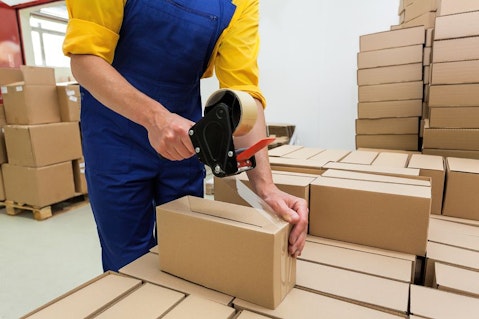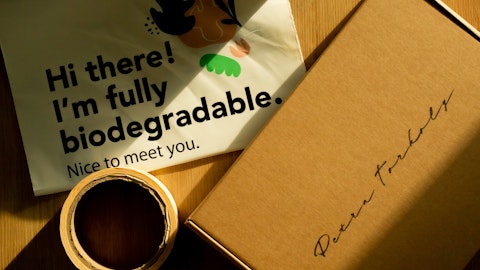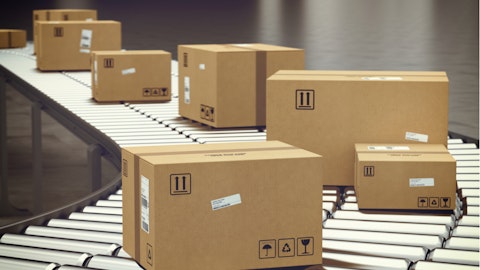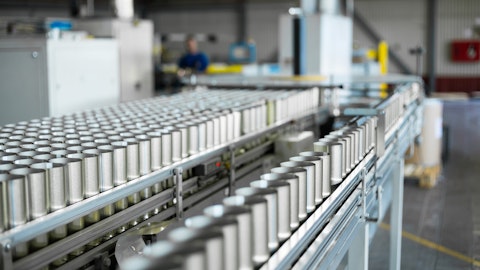Greif, Inc. (NYSE:GEF) Q3 2023 Earnings Call Transcript August 31, 2023
Operator: Good day, and thank you for standing by. Welcome to the Greif Third Quarter 2023 Earnings Conference Call [Operator Instructions]. Please be advised that today’s conference is being recorded. And I would now like to hand the conference over to your speaker today, Mr. Matt Leahy. Mr. Leahy, please go ahead.
Matt Leahy: Thanks, and good morning, everyone. Welcome to Greif’s Third Quarter Fiscal 2023 Earnings Conference Call. This is Matt Leahy, Greif’s Vice President of Corporate Development and Investor Relations. And I’m joined by Ole Rosgaard, Greif’s President and Chief Executive Officer; and Larry Hilsheimer, Greif’s Chief Financial Officer. We will take questions at the end of today’s call. In accordance with regulations fair disclosure, please ask questions regarding issues you consider important because we are prohibited from discussing material nonpublic information with you on an individual basis. Please turn to Slide 2. As a reminder, during today’s call, we will make forward-looking statements involving plans, expectations and beliefs related to future events.

Copyright: bialasiewicz / 123RF Stock Photo
Actual results could differ materially from those discussed. Additionally, we will be referencing certain non-GAAP financial measures and reconciliation to the most directly comparable GAAP measures [Technical Difficulty] the appendix of today’s presentation. And now I turn the presentation over to Ole on Slide 3.
Ole Rosgaard: Thanks, Matt, and good morning, everyone. Our global Greif team executed very well in our fiscal third quarter and posted strong performance despite a continuation of historic volume headwinds. Our teams are leaning on our Build to Last strategy to drive results in this difficult environment and I could not be more prouder of the work we are doing to manage and improve the business and better serve customers. Our performance in the first nine months of 2023 with strong EBITDA performance and margins and free cash flow conversion well above our targeted 50% is a testament to the growing resilience of our business model and our commitment to both manage the present while building the future. Before further covering our results, I want to share an exciting update on two of our key missions in our Build to Last strategy, creating thriving communities is a mission devoted to cultivating a culture of appreciation, inclusion and recognition for all our internal colleagues and external stakeholders.
In the third quarter, we launched our Colleague Stock Purchase Plan, a program that enables colleagues from corporate down through production to acquire Greif Class A shares at a discount to market prices. We believe in the power of ownership to drive greater accountability and commitment to excellence across the organization. And this program will provide the means for our colleagues to participate in the economic benefits of value creation. I’m proud to welcome our colleagues to the table as fellow owners of our company and look forward to expanding this program in the months and years to come. On our mission to deliver legendary customer service, each quarter, we present the latest results of our customer satisfaction index, a mechanism we used to formally receive regular feedback from customers on overall satisfaction with Greif in terms of product quality, customer service and our ability to deliver value.
Our aspirational benchmark of success is a score of 95 out of 100. This quarter, our global consolidated score was 94.2, just shy of that goal and an exceptional result given the challenges our customers are facing in the markets. Greif’s steadfast commitment to our customers is evident. We will provide you and support you and build on our existing relationships in good times and in bad, and you can count on us to deliver with quality and service excellence every day. Our dedication and relentless focus on customer service is core to who we are as an organization and our excellent CSI score during this challenging period is a reminder of the value we provide. Now I’d like to shift focus back to financial results on Slide 4, where I’ll turn it over to Larry to kick things off.
Larry Hilsheimer: Thanks, Ole, and good morning, everyone. Given Greif’s overall financial performance relative to the operating environment we have been in this year, we want to briefly step back from our single quarter results and just take stock of where the company is now relative to our initial view and fiscal ’23 guidance provided in December of 2022. At that time, we had started to see demand softness in many of our end markets and I discussed on our Q4 ’22 earnings call, how, given our level of uncertainty, we had run a robust scenario analysis to arrive at the wide guidance range for 2023 of $820 million to $906 million in EBITDA and $410 million to $460 million in free cash flow. I’ll be frank with everyone. While we considered at the time the possibility of an extended slow demand cycle, we did not weight that heavily as doing so would imply we felt that we were headed into another industrial recession.
Clearly, that initial assumption in December was wrong. And while we may not be in a broad economic recession, global manufacturing PMIs remained below 50 for the 11th month in a row, and our year-to-date volumes across GIP and PPS are both tracking down mid to high teens year-to-date. If that’s not indicative of an industrial recession, then I’m not sure what is. Another relevant comparison is the recessionary scenario slide we outlined at our Investor Day in June of last year showing downside risk to $600 million to $700 million of EBITDA and $260 million to $320 million in free cash flow. A few points comparing that scenario against our current environment: Number one, recession steel drum volumes assumed 5% down versus actual Q3 of down over 10%; recession [steel] index prices assumed down 20% versus the actual down of 15% through July; recession mill volumes assumed 5% down versus an actual down over 20% in Q3; recession containerboard prices assumed 10% versus the actual Q3 down about 8%.
To summarize, current steel drum volumes are tracking down double the downside scenario, mill volumes are down quadruple the downside scenario and overall pricing declines nearly match our downside scenario. And yet, our current guidance midpoint contemplates EBITDA and free cash flow that is over $100 million above the level we provided for a recession scenario with only a partial lift from M&A. I illustrate these points to try to hammer home how well our teams are executing. And I also want to share my heartfelt thanks to all of our Greif colleagues for their commitment and dedication this year. Ole, thanks for letting me take the time to boast about our team’s performance but is really commendable how well we are doing, and I’d like our investors to keep that in mind as they consider our detailed results.
Ole Rosgaard: Thanks, Larry and well said. As Larry just mentioned, we again reported strong adjusted EBITDA of $226.5 million, only $2 million shy of our previous quarter and less than $25 million short of the very strong 2022 comparative period. Our free cash generation was also extraordinary reported at $167.1 million, nearly equal to the very strong Q3 of 2022, but on volumes, which were more or less 15% lower. As mentioned in my opening remarks, that free cash flow figure represents a conversion rate of over 70%, which is well ahead of our long term target of more than 50%. Our disciplined approach to managing costs and working capital are driving this performance as we are truly playing with the entire piano, spanning from operational and commercial excellence initiatives to supply chain and sourcing and automation efforts, all to drive improvements across our business.
We also announced another step-up in our annual reoccurring dividends with our total quarterly dividend now at $0.52 and $0.78 for Class A and B shares, respectively. The strength of our balance sheet and growing free cash flow generation has widened our available capital allocation opportunities, and we are excited to continue to deliver cash to our shareholders. Lastly, I’m excited to announce another addition to the Greif portfolio. As this past week, we signed an agreement to acquire 51% ownership in ColePak, which I’d like to discuss more on the following slides. Slide 5, please. ColePak is a truly special paper converting business as the number two supplier of bulk and specialty partitions in North America. For those unfamiliar, a partition is a divider included commonly in corrugated boxes as a method of separating fragile content such as glass bottles.
ColePak manufactures a wide range of partitions from both URB and containerboard and predominantly serves the stable and growing food and beverage markets. They have two facilities in Avon, Ohio and in Fairfield, California, a site which is strategically located to serve the high end wine bottling business in the Avon Valley. This business is immediately margin accretive to the global Greif portfolio and is expected to contribute EBITDA before synergies of $15 million to $20 million per year. While the business is small relative to our global portfolio, several organic and inorganic growth opportunities remain to quickly grow and further scale this niche business. On top of the favorable stand-alone financials, ColePak’s converting network consumes approximately 25,000 tons of paper per year adding incremental downstream integration into our PPS network.
Last but certainly not least, ColePak’s management team is an excellent cultural fit to Greif. We have known and done business with the Cole family for years and share a set of values on how to take care of colleagues and serve customers. We are excited to partner with ColePak in this new venture and grow the business together. I’ll conclude by saying that even after the pro forma impact of this acquisition, our balance sheet remains in great shape and we sit below the midpoint of our target leverage ratio range. Our M&A pipeline remains robust and we intend to continue deploying capital towards more value accretive targets in the future. Now I’d like to shift gears and take a deeper dive into our segment results. So please turn to Slide 6.
Our GIP business produced an excellent result with flat year-over-year gross profit despite volume headwinds of nearly 20% in the Americas and nearly 10% in EMEA and APAC. Once again, the strict adherence to our value over volume philosophy in the markets, the benefits of our cost-out actions taken earlier this year and lower year-over-year input costs led to an adjusted EBITDA lift of nearly $10 million year-over-year despite substantially lower revenues. On the volume side, all GIP products and geographies showed softness compared to the prior year with global steel and resin based products, both down mid-double digits on a per day basis. Sequentially, our third quarter closely mirrored our second quarter with demand flat in EMEA and APAC and slightly down in LatAm and North America.
Through August, we do not have a line of sight into any notable upward demand inflections in our GIP business and we’ll continue to manage this business as we have through the year with a focus on cost and customer service. I commend our global GIP team for their exemplary performance in the third quarter and throughout 2023. Please turn to Slide 7. Paper Packaging’s third quarter sales declined $146 million year-over-year, primarily due to demand weakness across our converting businesses and mills. We took approximately 55,000 tons of economic downtime across our mill system in the third quarter as we faced nearly 10% per day volume declines across our primary converting operations. The continued low volume environment, combined with rising OCC costs during the quarter, led to both EBITDA dollars and EBITDA margin compression compared to prior year.
That said, our PPS team utilized the same playbook as GIP in reference to value over volume and cost elimination, resulting in a still healthy 7.4% EBITDA margin for the quarter. Our PPS team is managing the business very well against multiple headwinds, and I’m proud of their results and continued dedication during these challenging times. I will now turn the presentation over to Larry on Slide 8.
Larry Hilsheimer: Thank you, Ole. As Ole and I mentioned in earlier prepared remarks, our team is executing well in a historically challenging demand environment. It is an enterprise-wide effort to deliver these results, and my heartfelt thanks goes out to each department within Greif for delivering for our customers and our shareholders this year. Back to the Q3 financials. Sales decreased approximately $290 million year-over-year, primarily due to lower volumes and the impact of significantly lower steel costs. Despite this, adjusted EBITDA declined less than $25 million, leading to over 150 basis points of margin expansion. Most impressive, however, was our free cash flow performance. Cash flow dollars were down only $8 million year-over-year on substantially higher free cash flow conversion.
Just to remind everyone, Q3 of last year was the highest third quarter cash flow in the history of our company and we missed it this quarter by only $8 million with $290 million lower sales. Volume is down nearly 15% year-over-year, higher CapEx and $11 million of higher interest costs related to higher rates in our recent M&A activity, that’s truly outstanding. To put it another way, on a trailing 12 month basis, our adjusted free cash flow is tracking at $580 million more than double the average annual free cash flow generated between our 2019 and 2021 fiscal years. On any measure, the cash output of this company is miles ahead of where it once was and we still do not believe that, that fact is fully recognized by the market. We have raised the bar on performance and the elevated cash flow dynamic has opened up a lot of possibilities for further value creation through M&A and returning cash to shareholders.
And now I’d like to touch on our other capital allocation priorities on Slide 9 before discussing guidance. Ole discussed the recent acquisition of ColePak in his remarks. We’re pleased to be taking another step on our Investor Day commitment to grow downstream integration in our paper system at the same time, we’re pursuing our resin based acquisition cap and GIP. We have spent over $550 million on M&A over the last nine months, but our work is not done and our pipeline remains robust. We expect to continue generating sufficient cash to fund various actionable opportunities and still maintain a strong balance sheet. In addition to pursuing inorganic growth, I’m excited to announce we are again raising our dividend, fulfilling a commitment we made to investors over a year ago.
While our dividend yield may no longer be industry leading, thanks to some long overdue appreciation in our stock price, it is still one of the most compelling dividend offerings in our industry. By raising our dividend for the coming year by 4%, we are reaffirming our commitment to deliver cash directly back to our shareholders. As our business grows, we expect to grow our dividend at a commensurate rate to ensure shareholders are fairly compensated for their commitment to us. And finally, as you recall, last quarter, we completed our $150 million share repurchase program. And while we are not executing on any current buyback programs, we retain an open authorization for 2.6 million shares and may execute further repurchases opportunistically in the coming years.
With that, I’d like to close by discussing our revised guidance on Slide 10. As you can see, the midpoint of our guidance for EBITDA and free cash flow remains unchanged. Given the closer line of sight to full year results, we are tightening the range by $10 million on each side and now expect full year EBITDA to land between $790 million and $820 million and full year free cash flow between $400 million and $430 million. Our overall third quarter financial results largely met our expectations. However, the individual drivers defer. Volumes were below plan in nearly all substrates, but margins were better for the reasons previously mentioned. As with prior quarters, our current forward guidance assumes no improvement on volumes through the end of the year.
Additionally, we will plan to share our views on fiscal ’24 in our Q4 call in early December. We expect to finish the year with another quarter of strong performance despite the persistent macroeconomic challenges we face. I’d like to remind everyone that the midpoint of our guidance range implies the second best financial performance in Greif’s 145 year history surpassed only by a record year in 2022. We are confident that we’ve set a new bar for performance and expect that we will continue to deliver these exceptional results as we make future progress on our Build to Last journey. Ole, I’ll hand it back to you to close on Slide 11.
Ole Rosgaard: Thanks, Larry. As Larry just mentioned, our guidance reflects the expectation of the second best year in Greif’s 145 year history, and we are extremely proud to be in that position considering the headwinds we have and are facing. Great companies often improve their work in times of great difficulty through perseverance, grits and dedication to excellence. Built on that is how we demonstrate that perseverance and I see it daily in the passion of our colleagues and decision making at every level of our business. We are well positioned for a demand rebound whenever that comes. And in the meantime, we are excited to continue building this business and making progress on our long term strategy. We thank you for your interest in Greif. Operator, please open the line to questions.
See also Long-Term Returns of David Einhorn’s Activist Targets and Top 20 Fruit Producing Countries In The World.
Q&A Session
Follow Greif Inc (NYSE:GEF,GEF.B)
Follow Greif Inc (NYSE:GEF,GEF.B)
Operator: [Operator Instructions] And our first question will come from Michael Hoffman of Stifel.
Michael Hoffman: I look forward to seeing you next week in Paris and London. When we finished 2Q, I have in my notes, if I’m wrong, I accept that I’m wrong. I had in my notes, the cadence in the second half was going to sort of EBITDA was on track around a couple of hundred million in the 3Q and then improve modestly into 4Q to hit the midpoint. You beat the outlook for 3Q, given your again, repeated exceptional performance around cost, that has the fourth quarter down pretty healthy. How my — what is my interpretation of the implied EBITDA being $185 million versus something that was like low 200, 210 originally.
Larry Hilsheimer: Yes, Michael, you’re correct. I mean the Q3 ended up being better on the margin side, volume degradation though, was more than we expected and we don’t see that volume picking up. And we’ve seen ag perform less favorable than we normally do. So with that trend, it just shifted things a bit. We also had anticipated that we would have some — a tax refund item that is in Latin America is like $6 million. We had anticipated that might occur later, it came into the third quarter, is actually a noncash item as well, which really impacted cash flow a little bit. But it’s really those two items. Obviously, we hope volumes will pick up and surprised us a bit in the fourth quarter but we have not seen that in August yet.
Michael Hoffman: And then to that point, we’ve talked before about sort of major end markets and GIPs, sort of chemical paints and coatings and lubricants. So are we hearing a message that it’s not worse it’s just not any better, or has some of those got worse?
Ole Rosgaard: Our customers are telling us that it’s not getting worse, but they’re also telling us that they don’t expect any improvements over the next two quarters. So from what we hear, we will be in the second quarter of 2024 before they see an even any remote chance of improvements. So that’s what we hear from our customers.
Michael Hoffman: And then on PPS, I cover things that recycle all this OCC and that into my coverage says that they’re starting to see improving demand. So is there a light at the end of the tunnel and all of this — the finished goods inventory clearing and demand starts to improve?
Ole Rosgaard: Mike, I think part of what’s created a little bit of demand on the waste companies for the OCC side of things is really just related to some new mill capacity opening in recycled mills. Outside of that word, we saw a couple — times over the last month or so where we saw a spike in orders for a week, but then the next week, they fell back off. So we haven’t seen anything sustained that would indicate any lift, and we’re not hearing anything from our customers in the paper business that gives them any real solid indications of a inflection point.
Michael Hoffman: But it sounds like you feel like you have hit a bottom. If you’re getting momentary spikes, you’ll probably hit a bottom.
Ole Rosgaard: Yes, we hope so. I mean, we think that, but we thought the second half of this fiscal year would be good, and I missed that call. So I’m not really good with my crystalball.
Michael Hoffman: Yes, you and I both. And then last one for me is one not own 100% of Cole?
Ole Rosgaard: This is a deal that, because of our long relationship with them, they approached us to help because of growth opportunities. But maybe I’ll let Matt talk a little bit about that because Matt leads our business development efforts and dealt with the Cole family on this…
Matt Leahy: So Michael, the reason to not own 100% is that we and the Cole’s believe that there is substantial growth opportunity ahead, and we want to have aligned incentives as we try to grow that business together. Part of the partnership, the reason it makes sense is because they see real opportunities in the market to grow substantially, but they need to make sure they have the mill capacity to do it. So that’s the strategic rationale. We’re excited about adding into the portfolio from a margin perspective, from an end market perspective, but I also think that, that 51% ownership stake and partnership going forward makes sense for both of us to maximize the growth and value creation of that business over time.
Ole Rosgaard: And they’re highly respected in the industry because of sort of their word is their bond kind of thing, they’re good people, they’re Ohio people, and they want to participate in the growth.
Operator: [Operator Instructions] Our next question will come from the line of Ghansham Panjabi of Baird.
Ghansham Panjabi: I know it’s very difficult to disaggregate. But on the volume decline in GIP, how would you separate end market weakness versus any incremental destocking at the customer level? And I’m just asking that because as raw material prices started to decline for some of your customers, they did start to accelerate destocking, and just kind of wondering where we are in that phase.
Ole Rosgaard: We don’t think that destocking has come to an end, but it’s difficult just to see whether it’s really come to an end. But we believe what we see now is really there’s a manifestation of extremely low demand in the markets, if that’s helpful.
Ghansham Panjabi: And then in terms of the margin improvement in GIP, which has been obviously very notable in the context of the volume declines you’ve cited. How should we think about incrementals as volumes eventually recover? And I’m just asking because are there any big cost reversal headwinds we should keep in mind in that scenario?




